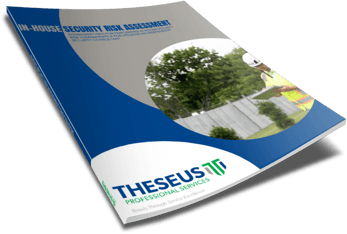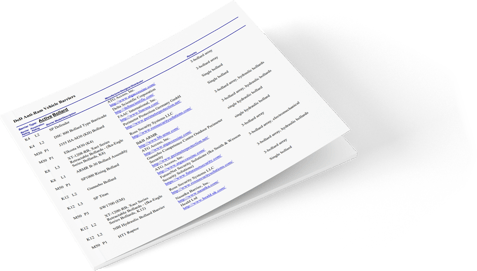3 min read
White House Truck Attack Thwarted: Learn More About Vehicle Barriers and Bollards
![]() Theseus Team
:
May 23, 2023 9:31:22 AM
Theseus Team
:
May 23, 2023 9:31:22 AM

Last week a congressman's staff was attacked by a man with a baseball bat in Virginia. This morning, a 19 year old suspect used a moving truck to attempt to drive through vehicle bollards at the White House.
Let's review and consider why vehicle bollards and barriers are a good idea to protect sensitive buildings, campuses, and areas where pedestrians need to be separated from vehicles such as outdoor shopping districts or areas of congregation.
Here's our Top 10 Considerations List:
-
Vehicle Intrusion Prevention: By installing vehicle barriers, security professionals can effectively deter or prevent vehicle-based attacks such as ramming, crash-and-grab, or vehicle-borne improvised explosive devices (VBIEDs).
-
Mitigating Vehicle-Based Threats: Vehicle barriers can help mitigate the risks associated with hostile vehicle attacks, providing a critical response time for security personnel to assess and neutralize potential threats.
-
Access Control and Restricted Entry: Vehicle barriers enable security professionals to control and restrict vehicle access points, allowing only authorized vehicles to enter the premises. This helps prevent unauthorized entry and increases overall security.
-
Physical Deterrence: The presence of visible vehicle barriers acts as a deterrent to potential attackers, discouraging them from attempting to breach the protected area and signaling a strong security posture.
-
Flexibility and Scalability: Vehicle barriers come in various types, including bollards, gates, and retractable barriers, allowing security professionals to choose the most suitable options based on their specific needs. They can also be easily integrated into existing security systems and expanded if required.
-
Safety of Pedestrians: Vehicle barriers can create secure pedestrian zones within the high-security building or campus, ensuring the safety of individuals by keeping unauthorized vehicles away from areas where people gather or move.
-
Emergency Response Support: Vehicle barriers can assist emergency response teams by allowing controlled access for authorized vehicles during critical situations while simultaneously preventing unauthorized vehicles from entering, aiding in maintaining order and managing incidents effectively.
-
Regulatory Compliance: In some regions, certain high-security buildings or campuses are required by law to implement vehicle barriers to meet specific security standards. Using vehicle barriers helps security professionals ensure compliance with these regulations.
-
Reputation and Stakeholder Confidence: Employing vehicle barriers demonstrates a commitment to security and the protection of people and assets. This can enhance the reputation of the high-security building or campus, instilling confidence in stakeholders, occupants, and visitors.
- Aesthetics: Vehicle barriers can be deployed in a variety of architecturally pleasing designs from decorative to institutional, allowing the barriers to blend into the environment while still performing the desired task of stopping vehicles from entering an area. Here are a few examples of bollard and barrier types >>

.gif?width=370&height=381&name=Bollards%20and%20Barriers%20gif%20(Concentric).gif)
Note: It is important to consult with security professionals, architects, and relevant experts to determine the most suitable vehicle barriers and security measures based on the specific requirements of each high-security building or campus.
Ratings
Vehicle barriers are given a Barrier Rating and Penetration Rating. There are a variety of standards and requirements that must be considered during the design and selection process such as ASTM F2656/F2656M-20.
Knowing the threat vehicle, the velocity it is expected to attain, and the acceptable penetration distance provides the ability to select an appropriate barrier for site specific conditions around a facility. The variables considered for different test conditions include the following:
- Vehicle speed (from 30–60 mph, depending on the threat vehicle)
- Vehicle type (small passenger car up to heavy goods truck)
- Vehicle weight (2430 lbs to 65,000 lbs, depending on the threat vehicle)
- Condition Designation (based on threat vehicle and velocity, equivalent to K-rating in former State Department standard)
- Penetration distance (DoS's L-rating; ASTM's P-rating)
The three standards are summarized in the table below from which comes this example illustrating use of the ASTM standard, as the increasingly preferred metric:
A M30 P1 crash barrier is designed to stop a Medium Duty Truck (M) traveling 30 mph with a penetration distance of ≤ 3.3ft
Source: https://www.wbdg.org/resources/bollard-crash-and-attack-resistant-models
The Department of Defense created a list of the ratings and acceptable manufacturers for security professionals to reference. Download here >>
Testing Videos
There are some really interesting videos showing testing of these devices with actual vehicles. Check them out here >>
Contact the Theseus team to discuss your environment, risk, architecture, and system integration expectations in order to create a solution design. Email us now >>
 FREE DOWNLOAD: SECURITY RISK ASSESSMENT CONSIDERATIONS GUIDE
FREE DOWNLOAD: SECURITY RISK ASSESSMENT CONSIDERATIONS GUIDE
Security professionals are constantly looking for innovative ways to secure their facility and provide a safe environment within their budget. And, they are also constantly looking for resources to help them achieve that mission while expert advice is hard to come by.
Fortunately, we have released a considerations guide that will help security professionals perform their own in-house security risk assessment.
What's Inside?
This guide is intended to assist you with performing an in-house physical security risk assessment. In many cases, assistance from a third-party expert, like Theseus Professional Services, is required.
Identification of missing or inadequate physical security measures that safeguard assets (people, property, and information) and critical business functions is of paramount importance. The findings of a security risk assessment are used to measure and communicate the level of risk to the organization.
- Process Evaluation
- Threats
- Vulnerability Assessment Highlights
- Electronic Security Systems Considerations
- Site Considerations
- Building Entrances and Exits
- Common Functional Areas
- Building Envelope
- Utilities and Building Services
- Building Systems






